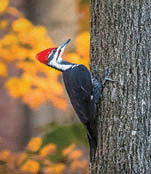Return to 3rd Quarter 2024 articles.



Woodpeckers can hammer 25 strokes while their heads travel more than 20 feet per second. If you banged your head into a tree for a few seconds, the results would be headaches, detached retinas, concussions, eye damage from flying wood chips, and massive skin damage. With all the talk about brain damage from football collisions, perhaps we can learn from the woodpecker design.
Many design features protect woodpecker brains. Their skulls are thick and heavily ossified to prevent shattering. Shock-absorbing tissue between the eyes and around the skull acts as a crash helmet. Spongy material separates the skull and bill. A sac of fluid surrounds human brains, but a tough membrane surrounds a woodpecker's brain to prevent it from bouncing around. The woodpecker brain is tiny, weighing a fraction of an ounce, so it has much less inertia than a human brain.
Woodpecker eyes are held tightly in place by bone and surrounding tissue to prevent damage. A membrane blinks over the eye to keep out wood chips. The nostrils are covered with fine bristly feathers or are narrow slits to protect the bird's air chambers. Woodpeckers have long tongues that reach deep inside tree openings to capture insects. The tongue wraps around inside the skull, further protecting the brain when the bird is hammering on the tree. The woodpecker's bill is solid and shaped like a chisel. Thick and strong neck muscles absorb the kinetic energy.
Woodpeckers are essential to forest ecosystems by controlling worms and insects that can cause blight and infections in trees. Design requiring so many specialized features is difficult to explain by a step-by-step evolutionary process. God's creatures are designed to do specific jobs, and “We can know there is a God through the things he has made” (Romans 1:20).
Picture credits:
© Alexander ImageAlexander Image/Bigstock.com
